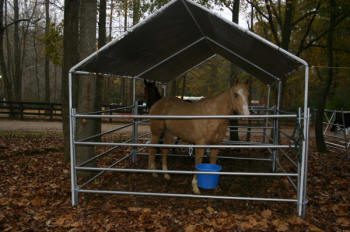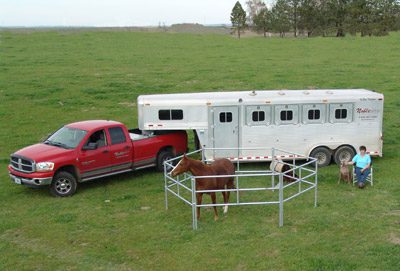
Outdoor recreation using mobile levadas
REST IN NATURE WITH THE USE OF MOBILE LEVADS
Many equestrians dream of getting out into nature with a horse for a few days. From our article you will learn how to ensure your pet’s safety during overnight stays during multi-day horse trips.
What inexpensive and easy to assemble can we use to open up a new unknown world for ourselves and our horse?
You will need a portable, easy to use, store and set up levada. With it installed, you can safely go to sleep in your tent, knowing that the horse is safe next to you. She can lie down, stretch herself, chew grass or hay, and most importantly, not suffer from a cramped horse carrier.
Exist two options for portable levada: electric shepherd and portable panels. Each of them has its own advantages and disadvantages. In any case, before you go on a trip, you will need to accustom the horse to being in the chosen variant of the levada at home, next to the stable.
Electroshepherd
What do you need?
1. Supports. They can be fiberglass (lighter and less expensive, but can delaminate when exposed to sunlight), polypropylene (metal tip at the base serves to strengthen in the ground, installed by pressing the foot on the ledge below) or metal (installed with tools, such as a hammer ) . Polypropylene and metal require insulation to hold the tape, polypropylene is self-insulated.
2. Electrical tape or wire: polyethylene tape pierced with conductive metal threads 2,5-7,5 cm wide, white or other color – very noticeable. The wider band makes the fence even more visible. A narrow, 2,5 cm tape is not very effective, as it contains few threads. Polymer-coated wire is cheaper, but breaks faster. To make the wire more visible, you will need markers (flags).
3. Power device: generator or solar battery (solar battery is quite bulky).
4. gate handle. Insulated handle with metal spring core, hook at one end and loop at the other for connecting tape or wire. Can be installed anywhere.
Advantages:
Flexibility. Complete kits are available, but you can also purchase individual items, arranging them the way you want. The size and shape of the levada is easily modified and can be adapted to any landscape and terrain.
Economy. About $150 – if you buy each item yourself. The set is not more than $200. (Editor’s note: for Russia, these figures may be different).
Ease of storage and transportation. One person can easily install and disassemble the electric shepherd. Tape or wire is stored in rolls. The supports are light and take up little space.
Disadvantages:
Such a levada is easily destroyed. The horse can reach through the tape for grass and break the fence.
In addition, the electric shepherd only works with charger. Horses are very aware of whether food is included or not. It is necessary to monitor the battery charge.
If the horse is walking in a blanket, the fence becomes less effective (the blanket protects your horse from electric shocks). However, the bottom band can still make contact with the legs and scare the horse away.
Portable panels


What is required?
1. Panels. Prefabricated panels are available in several weights and styles (steel and aluminium); one of the popular options is a set of 8 panels 180 cm long and 120 cm high. There are panels assembled according to the type of stall.
The connecting elements of the panels are strong enough, the horse will not be able to push the two panels apart by sticking his head between them.
Such panels can not only be purchased from the manufacturer, but also ordered independently at any welding shop.
Advantages:
Lack of supports is an advantage when installing a levada on hard and rocky ground. The panels will keep the frightened horse – he will not be able to destroy the fence and escape. Also solid appearance panels will stop the horse from trying to push the section out with the body.
Durability. The panels do not need maintenance for a long time.
Extensibility. You can adjust the area of your levada (it all depends on the number of panels).
Disadvantages:
Installation is much more complicated than that of an electric shepherd. If you don’t have much physical strength, you won’t install heavy panels, and light ones may not stop your horse from trying to escape. For this reason, many horse owners use lightweight panels in combination with an electric shepherd by adding one tape over the top of the panel! High cost. A set of four panels can cost you more than a full-fledged electric shepherd.
Introducing the Horse to the Portable Levada
If outdoor recreation is new to your horse, then you will have to introduce it to this type of activity. gradually. Before you begin, consider how adequate, calm and human-oriented your horse is? Believe me, a horse that is worried about leaving the stable, excited by every breath of wind or has a “hot” temperament is not the best partner for a multi-day trip!
If you are going to use an electric shepherd, familiarize your horse with its operation. Practice at home. Place a large electric shepherd so that the horse, when it first touches it and backs out, does not get tangled in the fence. Even if you are using a wide band, mark it with flags so the horse can see it better.
Make sure the charger is working, then bring the horse, leave it in the center and leave the shepherd. Close the fence. Stay within sight and sound – the horse should not panic if left alone. She will probably come up to the fence and try to touch it. Having received a charge, the horse will jump away, but, most likely, will try to touch again to test his experience.
If the horse is standing still, after a few minutes, come in, treat him with a treat and take him to the stable. Repeat this “training” daily, increasing the time the horse is in the electric shepherd, over several weeks. Make sure the horse is respected by the electric shepherd.
Is your horse accustomed to keeping in a small paddock? Neither the electric shepherd nor the portable panels will allow you to make a large paddock (you may not even have space to set it up). If your horse is constantly kept in a large paddock, and even with a herd, you need to spend time accustoming him to being in his own small pen. Install an electric shepherd or levada from portable panels where the horse will have the opportunity to contact through the fence with other members of the herd. Bring her water and hay. Watch her behavior. To begin with, leave it for an hour and a half, then gradually increase the residence time. The horse should get used to it quickly.
Pseudo overnight stays at the stable
Together with friends, organize a pseudo-hike within your stable. Install an electric shepherd or levada from portable panels and bring horses there. Set up tents for yourself. Check the condition of the horses during the night. If the horses are calmly chewing hay or sleeping, then this is a great sign.
Participation of an experienced equestrian tourist on your first trip
An experienced rider will help make your first trip safe for both you and your horse. Also, the horse will be calmer if it is not alone.
Tips
- Place the electric shepherd legs no more than 1,8 m apart, otherwise the tape will sag. The sections next to the exit on both sides should be even shorter. Use high supports (from 1 m and above). Pull the tape or wire over the top so that the horse does not lean on it. The second row, stretched below, provides additional security.
- Make your levada not too small so that a horse that lies down to rest or lie down does not get tangled in the tape or wire. It should not be large either, otherwise the horse will get space to make acceleration for the jump.
- Bring plenty of hay to the levada, even if it is on grass. The horse may trample the grass and break the levada in an attempt to reach the grass from the outside.
- Do not use a horse trailer as one of the sides of the left. The horse can injure himself about his part.
- If you are going out into nature in a large group, set up your levada so that the horse can see other horses as well. She will feel more secure.
- When installing portable panels, leave the horse in the horse carrier so that the noise does not frighten him.
Sandra Cook; translation by Valeria Smirnova (source)





